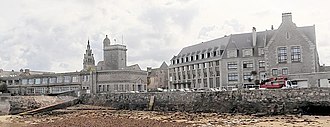Station biologique de Roscoff
The station biologique de Roscoff (SBR) (also: Laboratory for experimental zoology) is a marine biological and oceanographic research and teaching institution in France . It was founded on August 20, 1872 by the physiologist and zoologist Félix Joseph Henri de Lacaze-Duthiers (1821-1901) in Roscoff .
The institute is currently connected to the Sorbonne Université , the Institut National des Sciences de l'Univers et de l'Environnement (INSU) and the Center national de la recherche scientifique (CNRS) .
The following objectives are formulated: "Research, education and hospitality" (French: Ses objectifs: la recherche, l'enseignement et l'accueil ).
Your tasks are:
- Promote research and teaching on the biology of marine organisms and ecosystems,
- to ensure access to ecological and biological resources for both staff and foreign scientists,
- Conducting long-term observations on physical, chemical and biological properties of the environment in the coastal areas around Roscoff.
Research is carried out in the fields of molecular and cell biology , biochemistry and structural biology , bioinformatics , developmental biology , physiology , reproductive biology, genetics and population genetics .
The equipment includes two research vessels (12-meter and 7-meter vessels) and inflatables as well as diving equipment.
Overview
Roscoff is located on the north coast of Brittany in France, about 60 kilometers east of Brest and is characterized by an extraordinary variety of biotopes , most of which are accessible at low tide . These biotopes contain a large number of plants (700) and animals or marine animals (3000) in a terrain that is easily accessible at low tide within the intertidal zone and with acceptable lighting conditions even in winter.
The SBRs have around 200 permanent employees, consisting of scientists, teaching scientists, technicians, post-graduate students , doctoral students and administrative staff.
These employees are organized in research groups in research institutions recognized by the Center National de la Recherche Scientifique (CNRS).
The various research groups work on a wide range of topics, from studying the fine structure and function of biological macromolecules to global oceanic studies. Special emphasis is placed on the scientific approaches in genomics , especially by Marine Genomics Europe , which is coordinated by the SBR.
Teaching at the SBR includes courses that are part of the Master de l'UPMC and the European Socrates program . The SBR is part of the genomics network OUEST-genopole and operates a genomics platform for DNA sequencing and mass spectroscopy applied to biology ( Séquençage et spectrométrie de masse appliquée à la biology ).
The station has published a bilingual journal, the Cahiers de biologie marine (CBM) , since 1960 . The SBR also hosts between 12 and 15 national and international conferences per year, including the Jacques Monod conferences.
Historical overview
- August 20, 1872: The Laboratory for Experimental Zoology was founded by Félix Joseph Henri de Lacaze-Duthiers, Professor of Comparative Anatomy and Zoology at the Sorbonne. This is the third marine station after Concarneau ( Station biologique de Concarneau ) from 1859 and Naples Zoological Station Naples , Stazione Zoologica Anton Dohrn from 1872.
- 1881: Construction of the basin.
- 1891: Construction on the ground floor of the north wing of the laboratory Duthiers Lacaze.
- 1906: Construction of the first floor of the north wing of Labor-Duthiers Lacaze.
- 1934: Construction of the director's house.
- 1938: Construction begins on the Charles Perez Aquarium, which opened to the public in 1952 and has been closed for renovations since 2004.
- 1954: Construction of the CNRS Yves Marie Delage building (west wing).
- 1958: Acquisition of l'Hôtel de France , orientation of the canteen, conference rooms and rooms for visitors.
- 1969: Construction of the CNRS Georges-Teissier building (north and east wings).
- 2006: Acquisition of the hotel le Gulf Stream to increase the number of guests at the station.
List of directors
The directors of the station biologique de Roscoff: Félix Joseph Henri de Lacaze-Duthiers from 1872 to 1901; Yves Marie Delage from 1901 to 1920; Charles Pérez from 1921 to 1945; Georges Teissier from 1945 to 1971; Joseph Bergerard from 1971 to 1981; Interim ( Louis Cabioch , Pierre Guerrier ) from 1981 to 1982; Pierre Lasserre from 1983 to 1993; André Toulmond from 1993 to 2003; Bernard Kloareg from 2004 until today.
List of research vessels
La Dentale end of the 19th century, Le Cachalot beginning of the 20th century, Le Pluteus first half of the 20th century, Le Pluteus II second half of the 20th century, La Mysis second half of the 20th century.
Web links
Individual evidence
Coordinates: 48 ° 43 ′ 37.2 " N , 3 ° 59 ′ 13.2" W.


